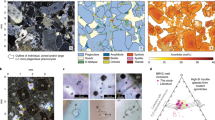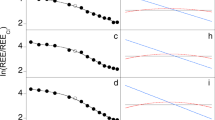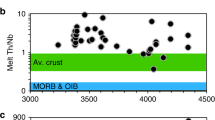Abstract
Many anorthositic plutons of the Nain complex were formed from highly feldspathic parental magmas, which were probably generated by melting or factional crystallization of tholeiite at 15–22 kbar. Their existence suggests a high geothermal gradient and thick continental crust during the mid-Proterozoic.
This is a preview of subscription content, access via your institution
Access options
Subscribe to this journal
Receive 51 print issues and online access
$199.00 per year
only $3.90 per issue
Buy this article
- Purchase on Springer Link
- Instant access to full article PDF
Prices may be subject to local taxes which are calculated during checkout
Similar content being viewed by others
References
Buddington, A. F. Geol. Soc. Am. Mem. 132, 477–488 (1972).
Bridgewater, D. & Windley, B. F. Spec. Publ. geol. Soc. S. Afr. 3, 307–317 (1973).
Isachsen, Y. W. N.Y. St. Mus. Sci. Serv. Mem. 18, 435–445 (1970).
Simmons, G. Bull. geol. Soc. Am. 75, 81–98 (1964).
Stephenson, R. & Thomas, M. D. Can. J. Earth Sci. 16, 24–37 (1979).
Keary, P. & Thomas, M. D. Geol. Ass. Can. Abstr. 4, 60 (1979).
Hubbard, F. H. & Whitley, J. E. Nature 271, 439–440 (1978).
Wiebe, R. A. Am. J. Sci. 279, 394–410 (1979).
Buddington, A. F. Geol. Soc. Am. Mem. 7 (1939).
Osborne, F. F. Trans. R. Soc. Can. 3rd Ser., sect. 4, 43, 85–112 (1949).
Morse, S. A. Geol. Soc. Am. Mem. 112 (1969).
Berg, J. G. Univ. Massachusetts Geol. Dept. Contr. 13, 107–119 (1974).
Planansky, G. A. Univ. Massachusetts Geol. Dept. Contr. 11, 83–89 (1973).
Wiebe, R. A. J. Petrol. 20, 239–269 (1979).
Wiebe, R. A. Can. J. Earth Sci. 15, 1326–1340 (1978).
Streckeisen, A. Earth Sci. Rev. 12, 1–33 (1976).
Berg, J. H. J. Petrol. 18, 399–430 (1977).
Jaeger, J. C. in Basalts, 530–536 (Interscience, New York, 1968).
Philpotts, J. A. & Schnetzler, C. C. Geochim. cosmochim Acta 34, 307–322 (1970).
Schilling, J. G. & Winchester, J. W. Contr. Miner. Petrol. 23, 27–37 (1969).
Simmons, E. C. & Hanson, G. N. Contr. Miner. Petrol. 66, 119–135 (1978).
Emslie, R. F. Yb. Carnegie Inst. Washington 69, 148–155 (1971).
Green, T. H. Can. J. Earth Sci. 6, 427–440 (1969).
Emslie, R. F. Precamb. Res. 7, 61–98 (1978).
Author information
Authors and Affiliations
Rights and permissions
About this article
Cite this article
Wiebe, R. Anorthositic magmas and the origin of proterozoic anorthosite massifs. Nature 286, 564–567 (1980). https://doi.org/10.1038/286564a0
Received:
Accepted:
Issue Date:
DOI: https://doi.org/10.1038/286564a0
This article is cited by
-
First estimate for the age of a mesoproterozoic palaeomagnetic pole from the Volodarsk-Volynsky Massif, the Ukrainian Shield
Studia Geophysica et Geodaetica (2005)
-
Alkalic to transitional ferrogabbro magma associated with paleohelikian anorthositic plutons in the Flowers River area, southeastern Nain igneous complex, Labrador
Contributions to Mineralogy and Petrology (1988)
-
The petrogenesis of massif anorthosites: a Nd and Sr isotopic investigation of the Proterozoic of Rogaland/Vest-Agder, SW Norway
Contributions to Mineralogy and Petrology (1988)
-
The petrology and geochemistry of massif anorthosites and gabbros of the Bavali fault zone, North Kerala
Journal of Earth System Science (1986)
-
A lower crustal origin for massif-type anorthosites
Nature (1984)
Comments
By submitting a comment you agree to abide by our Terms and Community Guidelines. If you find something abusive or that does not comply with our terms or guidelines please flag it as inappropriate.



